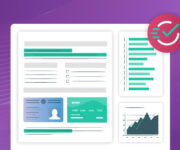As the world plunges into a climate emergency and the worst pandemic of the century ushers in a monumental change in the way businesses work, paperless ought to take a central role. The IDC, for instance, predicted, 400 billion fewer pages will be printed in 2020, thanks to the pandemic-induced isolation and rush to digitise.
The financial industry, of all, has traditionally been paper-oriented in its documentation and processing. But that is now about to change. Several factors are ushering in the paperless era: climate change, digitisation boom, quick processing trend, and not the least but competition.
Hence, financial solutions that support paperless lending are rapidly becoming mainstream to ensure a competitive ecosystem and reduce reliance on paper. However, the widespread adoption of digitisation is too risky to ignore and too large to miss. In this article, we will reflect upon the importance of digital transformation in the lending industry.
Need for Paperless Lending
Traditional loan processing is paper-heavy, time-consuming, and human-intensive. On average, it takes over a month to close a loan. In addition, the technical limitations of paper-based legacy lending systems result in lost sales, incomplete paperwork, delivery delays, and unwanted expenses.
As businesses move to digital platforms, there is still an incredible amount of paper usage. According to The World Counts, paper accounts for around 33% of municipal waste and 25% landfill waste.
Some of the costs involved in paper-based loans include:
- Labour costs to rectify and type errors.
- Expenses made in design, print, and storage of paper documents
- Loss of customer trust if files are damaged or lost
- On-site or off-site secure storage of completed loans
For an institutional transformation, we must reduce this gap between traditional lending and fully integrated digital lending.
So what is digital or paperless lending?
Digital lending encompasses all products and services that enable customers and businesses to access credit facilities via the internet without visiting a physical branch. Notably, the current COVID-19 pandemic has sped up the need for new technologies to tackle the economic challenges posed by the crisis.
From tightening credit conditions to falling demand and reduced input supply, digitisation and open application programming interfaces (APIs) are necessary to patch the ailing economy. But when it comes to paperless lending, can it be truly ‘paperless?’ Many governments worldwide mandate wet-signature before loan sanctioning or mortgaging, for instance.
In this case, paperless lending will cut down the need for paper whenever possible. But legacy lending systems may not be fully ready for digitisation. So what does it need to go entirely or mostly paperless?
Key Components of Digital Lending
These are the principal components of a lending system that are essential for paperless lending:
Digital Platforms
Modern lenders leverage digital channels to originate and renew loans using smartphones and a pool of unstructured and structured data for faster and efficient decision-making. In addition, effective digital media allow better customer engagement and support customer data collection by the financial service provider.
Beyond the more straightforward environmental benefits, the perks of going paperless are manifold. An online real-time lending platform can incite an always-on and hyper-connected experience from better loan disbursement to cross-channel support.
Today’s younger generation values digital-first finance solutions and instant gratification, making online lending platforms the sweet spot for personal loan lenders. How many times did you see an ad on Facebook wherein a specific bank offers loans and bank accounts in a few clicks?’ The transformation is here!
Digitised Data
Data for credit underwriting, customer data verification, fraud prevention, and product customisation is an essential element of digital lending.
Shifting from asset-based data, surrogate data sources like spending patterns, social media, utility payments, etc., are fed into algorithms to predict repayment readiness and capacity.
Once the digital processes from structured and unstructured data are in place, it takes a day barely to make the credit decision.
Further, digitally available data can paint a more accurate picture of a borrower’s creditworthiness and gauge the associated risk for credit underwriting.
With increased digitisation, bank statements reflect more completeness and give detailed borrower behaviour.
The best lenders make sophisticated use of data pulled from several reliable sources to make the right decisions and get their product offerings to businesses quickly.
Customer Experience and Engagement
Customer experience is a significant driver of the shift to digital. Today, digital borrowers expect everything from onboarding to loan-granting to be smooth.
Good experience in online lending leads to lifetime value and better customer retention. Such services also ensure more access to finance for small- and medium enterprises (SMEs), which means more financial inclusion.
One of the initial steps towards a solid customer experience is onboarding. Lenders can convert customers with advanced software, customer analytics, advisors and chatbots, mobile-friendly websites, and banking applications.
In addition, onboarding costs are cut significantly with the reduction/elimination of paperwork. Did you know that more than half of the SMEs (65%) spend somewhere between $1K to $5K for paperwork a year?
The next step is to improve customer engagement. Technologies like big data help in the easy deployment of data that can help understand customer needs and build engagement tactics.
This can be done by innovative product offerings like targeted promotions or personalised communications.
Even in today’s uncertain economy, any lending business’s secret sauce caters to customers from diversified backgrounds through a seamless digital process.
A new whitepaper from Xerox says SMEs at large are optimistic for a business rebound in 2021 and beyond. And 82% of the SMEs think harnessing digitisation of paperwork is essential to survive in a post-Covid world.
How Digital Lending Helps Reduce Agent Movement
Digital-based models are slowly and increasingly receiving whole-hearted acceptance for contactless businesses.
For example, lending agents access a digital workspace with paperless lending systems, avoiding the tedious to-and-fro visit to the physical banks.
The efficiency helps prevent the hassle of maintaining multiple forms and filings, the cost associated with maintaining the physical documents—personal documents, identity proofs, bank statements, salary slips—to keep everything in one place.
Needless to say that the presence of an agent—a middleman—can lead to added costs in the process if the benefits are not passed onto the customer, eventually losing out on potential returns.
Leveraging the ground-breaking capabilities of technologies like artificial intelligence (AI), big data, blockchain, and cloud computing can streamline the workflow and reduce the turnaround time without the need for additional agents.
Future of Digital Lending
Digital lending is one of India’s fastest-growing fintech sectors, having grown from nine billion dollars in 2012 to approximately 110 billion dollars in 2019.
By 2023, it was predicted that the digital lending sector would be worth roughly 350 billion dollars, according to global data research firm Statista.
Fintech startups and non-banking financial enterprises dominated this market (NBFC).
Considering how dynamic digital lending is, lending institutions evolve out of their silos to match the current market and customer needs.
Digitisation for customers can create frictionless experiences and deliver “wow” moments in their loan journeys and additionally help to:
- Reduce lending costs
- Increase profitability
- Better utilise human resource
- Seamless back-end checking
- More client satisfaction
- Increasing conversion rates
- Faster turnaround times
Finezza helps to remove redundant manual practices and streamline front-to-back workflows for new-age lending. Reach out to us today!




Leave a Reply